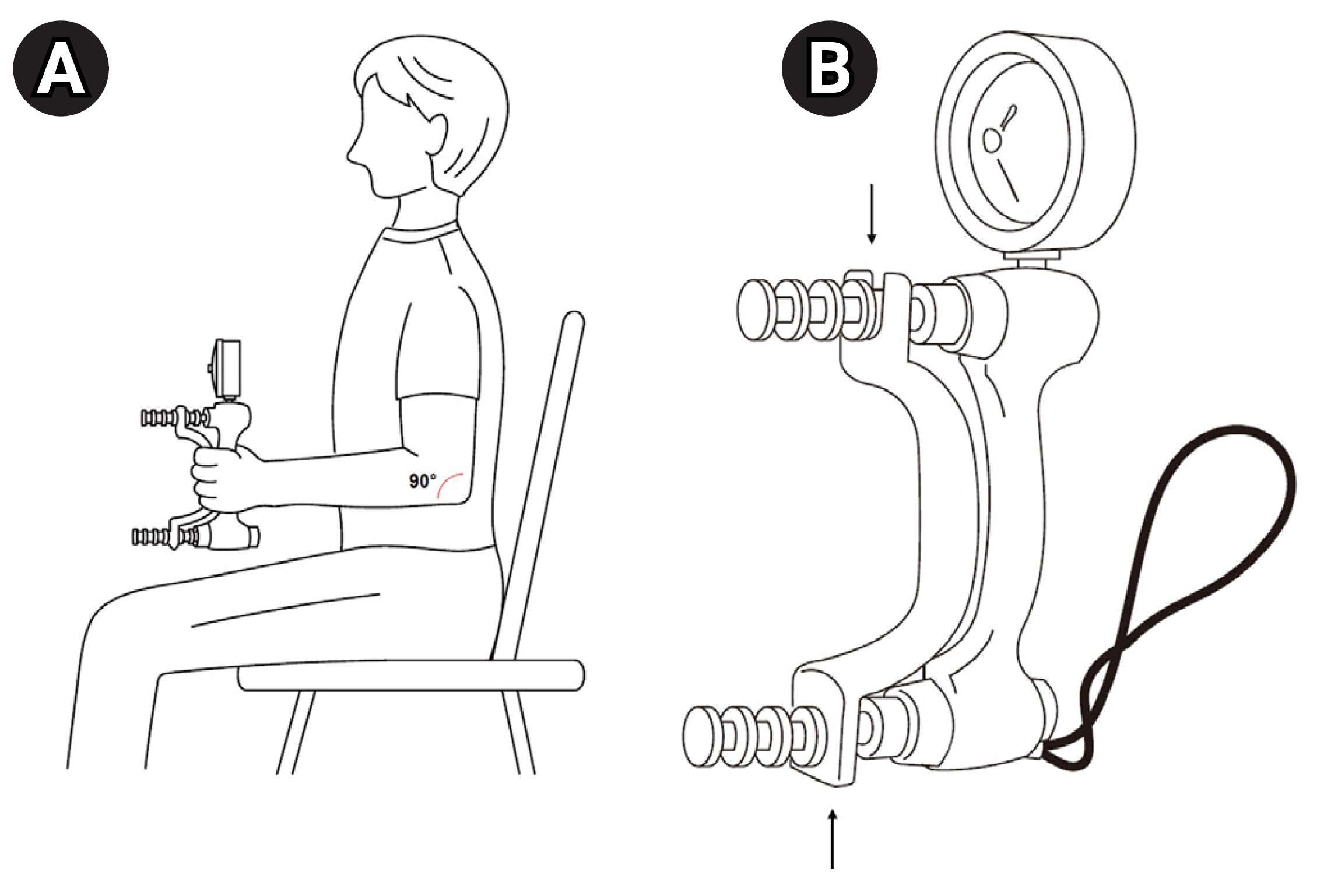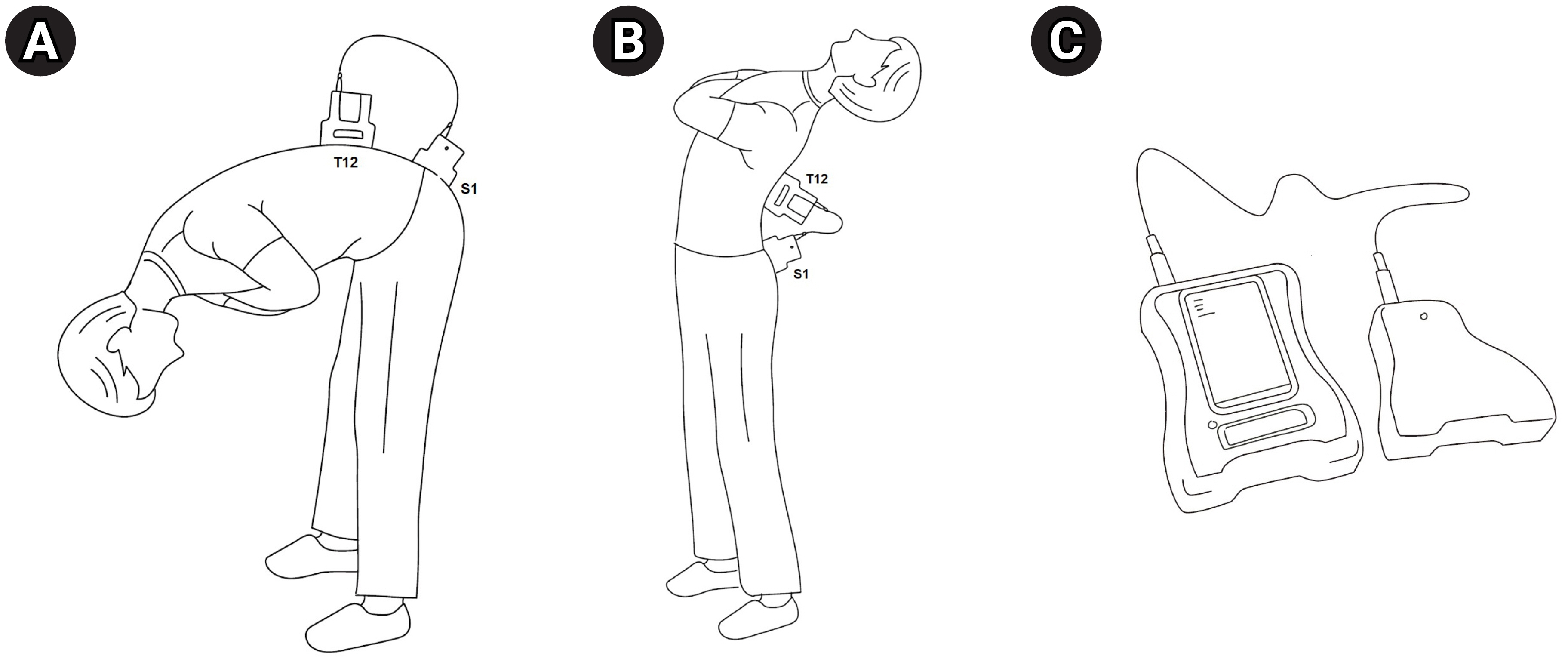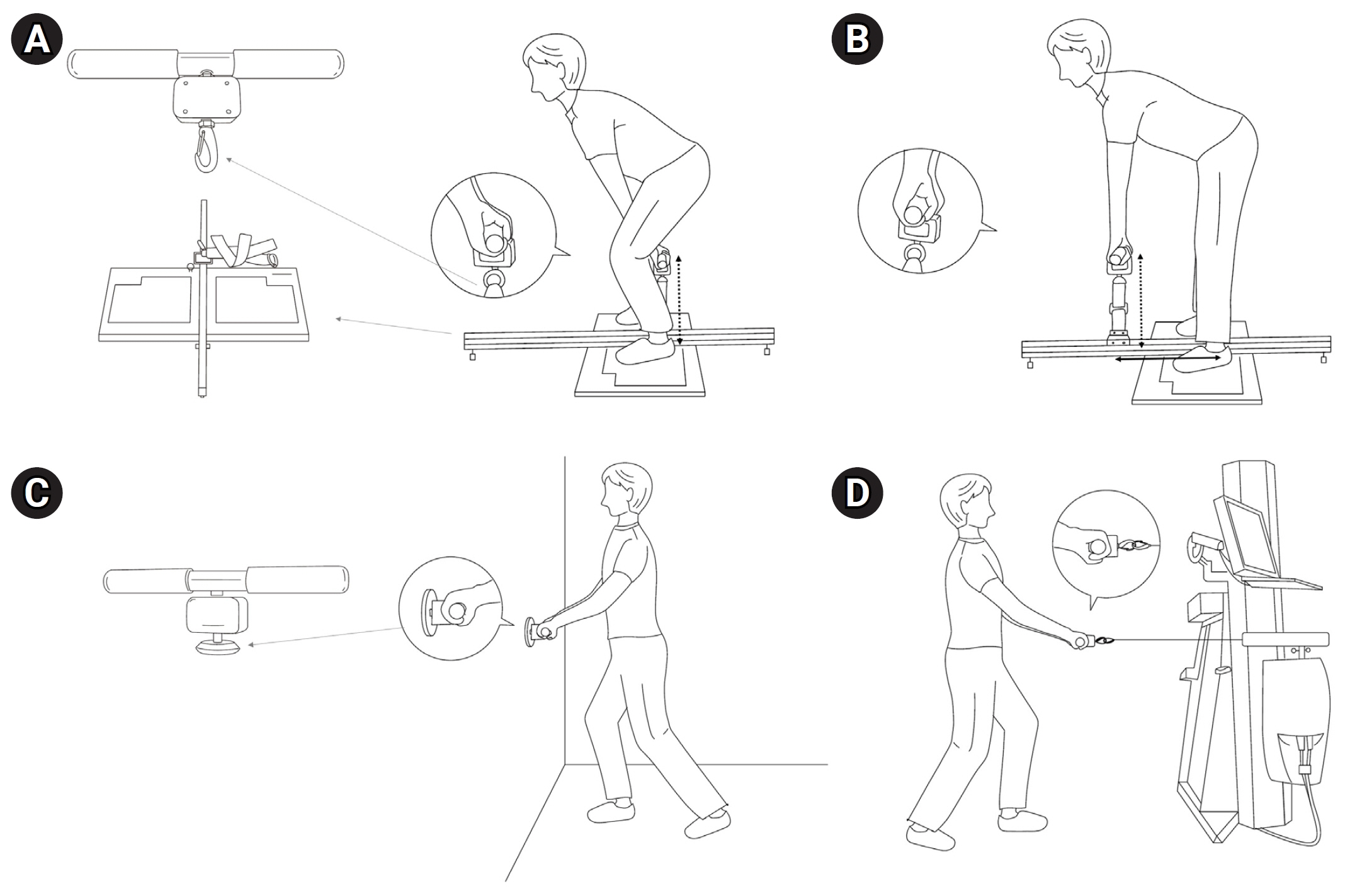Ann Rehabil Med.
2023 Dec;47(6):468-482. 10.5535/arm.23055.
Comprehensive Physical Work Capacity Evaluations for Korean Farmers Assessed in Healthy Volunteers
- Affiliations
-
- 1Department of Rehabilitation Medicine, Kangwon National University Hospital, Kangwon National University College of Medicine, Chuncheon, Korea
- 2Center for Farmers’ Safety and Health, Kangwon National University Hospital, Chuncheon, Korea
- KMID: 2549728
- DOI: http://doi.org/10.5535/arm.23055
Abstract
Objective
To establish the lower limits of normative values of the physical work capacity for Korean farmers in healthy working individual.
Methods
We developed a comprehensive set of physical work capacity evaluation items that encompass common farming tasks. These items include measurements of trunk flexion/extension angles, strength (hand grip, trunk flexion/extension, leg/back lifting, and pushing/pulling), and positional tolerances. We calculated the normative values for the items and defined the normal range in 124 healthy volunteers aged 20–79 years. We calculated the intraclass correlation coefficient (ICC) to validate the test-retest reliability of the measurements protocol.
Results
The normal values for each measurement item were as follows: trunk flexion and extension angle (65.3°±11.6° and 29.6°±6.6°), dominant hand grip strength (32.2±10.5 kgf), trunk flexion and extension strength (288.4±119.0 N and 297.3±129.9 N), leg and back lifting strength (452.9±233.5 N and 349.2±166.7 N), pushing and pulling strength (214.7±75.1 N and 221.7±63.3 N), and positional tolerance time (squat: 76.8±9.0 seconds, front: 73.8±7.7 seconds, twist: 82.2±8.8 seconds, upward: 71.9±11.3 seconds). Regarding test-retest reliability, all strength measurements demonstrated excellent absolute agreement (ICC, 0.91–0.96). However, positional tolerance showed poor-to-moderate absolute agreement (ICC, 0.37–0.58).
Conclusion
We conducted measurements of muscle strength and positional tolerance in healthy participants of various ages, focusing on tasks commonly performed by Korean farmers. The outcomes hold significant value as they offer a pertinent instrument for assessing the appropriateness of workers, thereby carrying implications for rehabilitation objectives, legal evaluations, and work capacity assessments within the agricultural domain.
Keyword
Figure
Reference
-
1. Slebus FG, Sluiter JK, Kuijer PP, Willems JH, Frings-Dresen MH. Work-ability evaluation: a piece of cake or a hard nut to crack? Disabil Rehabil. 2007; 29:1295–300.
Article2. de Boer WE, Bruinvels DJ, Rijkenberg AM, Donceel P, Anema JR. Evidence-based guidelines in the evaluation of work disability: an international survey and a comparison of quality of development. BMC Public Health. 2009; 9:349.
Article3. American Occupational Therapy Association. Occupational therapy’s role in functional capacity evaluation [Internet]. American Occupational Therapy Association;2012 [cited 2023 Sep 20]. Available from: https://www.scribd.com/document/465845350/Functional-Capacity.4. Kuijer PP, Gouttebarge V, Brouwer S, Reneman MF, Frings-Dresen MH. Are performance-based measures predictive of work participation in patients with musculoskeletal disorders? A systematic review. Int Arch Occup Environ Health. 2012; 85:109–23.
Article5. Kuijer PP, Gouttebarge V, Wind H, van Duivenbooden C, Sluiter JK, Frings-Dresen MH. Prognostic value of self-reported work ability and performance-based lifting tests for sustainable return to work among construction workers. Scand J Work Environ Health. 2012; 38:600–3.
Article6. Pinzke S. Observational methods for analyzing working postures in agriculture. J Agric Saf Health. 1997; 3:169–94.7. Ahonen E, Venäläinen JM, Könönen U, Klen T. The physical strain of dairy farming. Ergonomics. 1990; 33:1549–55.
Article8. Tuomi K, Ilmarinen J, Martikainen R, Aalto L, Klockars M. Aging, work, life-style and work ability among Finnish municipal workers in 1981-1992. Scand J Work Environ Health. 1997; 23 Suppl 1:58–65.9. Rostamabadi A, Mazloumi A, Rahimi Foroushani A. Work Ability Index (WAI) and its health-related determinants among Iranian farmers working in small farm enterprises. J Occup Health. 2014; 56:478–84.
Article10. Hansson E, Hansson T, Jonsson R. Predictors for work ability and disability in men and women with low-back or neck problems. Eur Spine J. 2006; 15:780–93.
Article11. Brouwer S, Dijkstra PU, Stewart RE, Göeken LN, Groothoff JW, Geertzen JH. Comparing self-report, clinical examination and functional testing in the assessment of work-related limitations in patients with chronic low back pain. Disabil Rehabil. 2005; 27:999–1005.
Article12. Soer R, van der Schans CP, Geertzen JH, Groothoff JW, Brouwer S, Dijkstra PU, et al. Normative values for a functional capacity evaluation. Arch Phys Med Rehabil. 2009; 90:1785–94.
Article13. Baek S, Park J, Kang EK, Kim G, Kim H, Park HW. Association between ergonomic burden assessed using 20-item agricultural work-related ergonomic risk questionnaire and shoulder, low back, and leg pain in Korean farmers. J Agromedicine. 2023; 28:532–44.
Article14. Streibelt M, Blume C, Thren K, Reneman MF, Mueller-Fahrnow W. Value of functional capacity evaluation information in a clinical setting for predicting return to work. Arch Phys Med Rehabil. 2009; 90:429–34.
Article15. Cheng AS, Cheng SW. The predictive validity of job-specific functional capacity evaluation on the employment status of patients with nonspecific low back pain. J Occup Environ Med. 2010; 52:719–24.
Article16. Swinkels RA, Swinkels-Meewisse IE. Normal values for cervical range of motion. Spine (Phila Pa 1976). 2014; 39:362–7.
Article17. Crosby CA, Wehbé MA, Mawr B. Hand strength: normative values. J Hand Surg Am. 1994; 19:665–70.
Article18. Fess EE, Moran CA. Clinical assessment recommendations. American Society of Hand Therapists;1981. p. 1–17.19. Cocchiarella L, Andersson G; American Medical Association. Guides to the evaluation of permanent impairment. 5th ed. American Medical Association;2001. p. 1–613.20. Park HW, Baek S, Kim HY, Park JG, Kang EK. Reliability and validity of a new method for isometric back extensor strength evaluation using a hand-held dynamometer. Ann Rehabil Med. 2017; 41:793–800.
Article21. Caruso JF, Brown LE, Tufano JJ. The reproducibility of isokinetic dynamometry data. Isokinet Exerc Sci. 2012; 20:239–53.
Article22. Hopkins WG. Measures of reliability in sports medicine and science. Sports Med. 2000; 30:1–15.
Article23. Guilhem G, Giroux C, Couturier A, Maffiuletti NA. Validity of trunk extensor and flexor torque measurements using isokinetic dynamometry. J Electromyogr Kinesiol. 2014; 24:986–93.
Article24. Roth R, Donath L, Kurz E, Zahner L, Faude O. Absolute and relative reliability of isokinetic and isometric trunk strength testing using the IsoMed-2000 dynamometer. Phys Ther Sport. 2017; 24:26–31.
Article25. Koo TK, Li MY. A guideline of selecting and reporting intraclass correlation coefficients for reliability research. J Chiropr Med 2016;15:155-63. Erratum in: J Chiropr Med. 2017; 16:346.26. Baek S, Park HW, Kim G. Associations between trunk muscle/fat composition, narrowing lumbar disc space, and low back pain in middle-aged farmers: a cross-sectional study. Ann Rehabil Med. 2022; 46:122–32.
Article27. Perkio-Makela MM. Finnish farmers’ self-reported morbidity, work ability, and functional capacity. Ann Agric Environ Med. 2000; 7:11–6.28. Grgic J, Lazinica B, Schoenfeld BJ, Pedisic Z. Test-retest reliability of the one-repetition maximum (1RM) strength assessment: a systematic review. Sports Med Open. 2020; 6:31.
Article29. Reyes-Ferrada W, Chirosa-Rios L, Martinez-Garcia D, Rodríguez-Perea Á, Jerez-Mayorga D. Reliability of trunk strength measurements with an isokinetic dynamometer in non-specific low back pain patients: a systematic review. J Back Musculoskelet Rehabil. 2022; 35:937–48.
Article30. Hulens M, Vansant G, Lysens R, Claessens AL, Muls E, Brumagne S. Study of differences in peripheral muscle strength of lean versus obese women: an allometric approach. Int J Obes Relat Metab Disord. 2001; 25:676–81.
Article31. Maffiuletti NA, Ratel S, Sartorio A, Martin V. The impact of obesity on in vivo human skeletal muscle function. Curr Obes Rep. 2013; 2:251–60.
Article32. Hasan NAKAK, Kamal HM, Hussein ZA. Relation between body mass index percentile and muscle strength and endurance. Egypt J Med Hum Genet. 2016; 17:367–72.
Article33. Kriketos AD, Baur LA, O'Connor J, Carey D, King S, Caterson ID, et al. Muscle fibre type composition in infant and adult populations and relationships with obesity. Int J Obes Relat Metab Disord. 1997; 21:796–801.
Article34. Maud PJ, Shultz BB. Gender comparisons in anaerobic power and anaerobic capacity tests. Br J Sports Med. 1986; 20:51–4.
Article35. Bouchard DR, Dionne IJ, Brochu M. Sarcopenic/obesity and physical capacity in older men and women: data from the Nutrition as a Determinant of Successful Aging (NuAge)-the Quebec longitudinal Study. Obesity (Silver Spring). 2009; 17:2082–8.
Article36. Hicks GE, Simonsick EM, Harris TB, Newman AB, Weiner DK, Nevitt MA, et al. Trunk muscle composition as a predictor of reduced functional capacity in the health, aging and body composition study: the moderating role of back pain. J Gerontol A Biol Sci Med Sci. 2005; 60:1420–4.
Article37. Dekkers-Sánchez PM, Wind H, Sluiter JK, Frings-Dresen MHW. What promotes sustained return to work of employees on long-term sick leave? Perspectives of vocational rehabilitation professionals. Scand J Work Environ Health. 2011; 37:481–93.
Article38. Pas LW, Kuijer PP, Wind H, Sluiter JK, Groothoff JW, Brouwer S, et al. Clients’ and RTW experts’ view on the utility of FCE for the assessment of physical work ability, prognosis for work participation and advice on return to work. Int Arch Occup Environ Health. 2014; 87:331–8.
Article39. Chen YL, Lee YC, Chen CJ. Differences in lifting strength profiles between experienced workers and novices at various exertion heights. Int J Ind Ergon. 2011; 41:53–8.
Article
- Full Text Links
- Actions
-
Cited
- CITED
-
- Close
- Share
- Similar articles
-
- List of occupational diseases among farmers in Korea: a literature review
- Work-related musculoskeletal disorders in Korean farmers
- Differences in Farmer's Syndrome between Greenhouse-Melon Farmers and Rice Farmers
- Awareness of the Prevention of Work-Related Diseases among Farmers - Based on Qualitative Research Methods
- A Survey on Physical Complaints Related with Farmers' Syndrome of Vinylhouse and Non-vinylhouse Farmers







